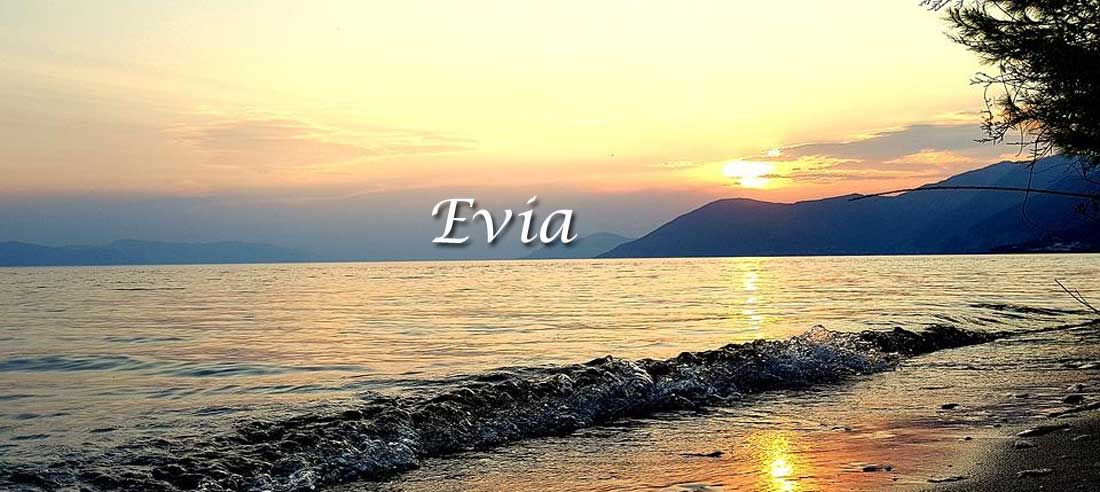The island of Evia (Eubea) Greece
Evia (Euboea) is the second largest island of Greece after Crete, and has a lot to offer. It is excellent for driving around on, since there are many villages and interesting places worth visiting. Of course, there are nice beaches as well, and depending on where you stay, you can enjoy some real peace and quiet, or a hectic nightlife.
Evia can be visited both in the winter and the summer. It has a ski center which is very popular amongst the Greeks, as well as places for water-sports. The island that has the narrowest sea crossing to the coast of Central Greece opposite the straits of Euripos.
Until recently, traffic between the island and the mainland passed over the old draw-bridge, which opened to allow ships to pass. From this bridge can be observed the periodic tides through the straits. The island is now linked with the mainland by a high-level bridge that shortens considerably the journey. The following are the main sites worth seeing at Chalkida.
The Kanithos fortress on the Boeotian coast, on the summit of a hill covered with pine trees, the Roman aqueduct, the Historical Archive, the Municipal Library, a number of mansions, and the churches of Ayia Paraskevi (St Paraskevi is the patron saint of the city), Agios Nikolaos, etc.The Archaeological Museum.
MAIN TOWNS
Chalkida
Chalkida is the capital and the most dynamic town of Evia. It acts as the administrative and commercial heart of the island and is famously known for the unique phenomenon of the tidal currents in the narrow strait of Euripus, which changes direction multiple times a day. The town offers a mix of modern amenities and historical sites, including a bustling waterfront, numerous cafes, bars, and restaurants, and landmarks such as the Red House and the old Ottoman mosque. The lively promenade and the medieval castle add to its touristic appeal.
Eretria
Eretria, to the south of Chalkida, is a town steeped in history. It was a significant city-state in ancient Greece, and today, its past is still visible in the ruins scattered around the area, including an ancient theater, temples, and a museum that houses artifacts found in and around the town. Eretria is also popular for its beautiful beaches and as a leisure destination for both locals and tourists looking to enjoy the seaside.
Karystos
Karystos is located further south and offers a more laid-back vibe compared to Chalkida and Eretria. Nestled at the foot of Mount Ochi, Karystos features an attractive mix of sandy beaches, crystal-clear waters, and an impressive medieval fortress, the Castello Rosso. The town is known for its friendly atmosphere and provides a perfect gateway for exploring the natural beauties of southern Evia, including several hiking trails that lead into the surrounding mountains.
Edipsos
Edipsos, on the northwest coast of Evia, is renowned for its thermal springs which have been attracting visitors for their therapeutic properties since ancient times. The spa town combines modern spa facilities with a range of hotels and resorts designed to provide healing and relaxation. The waterfront in Edipsos is lined with tavernas and cafes where visitors can enjoy local cuisine while viewing the sea.
HISTORY OF EVIA
Evia has been inhabited since pre historic times. Its most important settlement early became today’s Chalkida, since it was the closest to the mainland and had natural resources of copper, making the city a trading centre of great importance. The island’s name means “rich in cattle”.
During the 5th century it was part of the Athenian league against the Persians, and one of its most important centres was Eretria. It helped the colony Miletus during the Ionian revolt in 499BC, but when it failed, war with Persian was unavoidable. Eretria was destroyed by the Persians seven years after the revolt. In the 4th century BC it was an important cultural centre, and the Eretrian School of Philosophy was founded here.
The Romans invaded in the 3rd and 2nd century BC, and Evia became a vassal to the mighty empire, just like the rest of Greece.
During the Byzantine period many churches and monasteries were built o on the island, and it kept its trading status, even though parts of the island was raided by pirates from time to time.
The Venetians came in the 13th century, and Evia was to become a battle ground between them and the Turks, because of its strategic position.
The war of Independence began in 1821, and the people of Evia were to fight hard against their oppressors.
NORTHERN EVIA
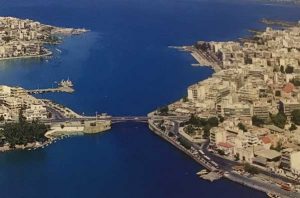
On the Kastri hill can be seen the remains of the ancient city of Kerinthos. The church of Ayios loannis o Theologos, built in the 19th c., is also of some interest. On its feast day, 26 September, there is a major festival, with traditional musical instruments and dancing. Visitors can swim at the beaches of Kymasi and Krya Vrysi. The road continues to Kirinthos, Strophylia and Ayia Anna. Ayia Anna is a traditional village that spreads around the slopes of a hill covered with pine trees. It has a small Folklore Museum containing local costumes, textiles, a photographic archive, household utensils, farming tools and other objects.
Angali on the coast (5 km to the east) is one of the finest beaches on Evia. The road continues north to Vasilika, a traditional villagein the foothills of Mount Xiros, 95 km to the north of Chalkida. The beach of Psaropouli attracts large numbers of holiday-makers in the summer and has crystal clear sea and fresh fish. We proceed northwards to Artemision, famous for the naval batle fought here during the Persian Wars. The famous bronze statue of Poseidon, on display in the National Archaeological Museum of Athens, was found in the sea off Artemision.
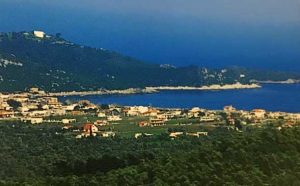
On the coast nearby at Kanatadika are the wetlands of Mikro and Megalo Livari, which attract rare species of wild birds. The picturesque harbour of Orei has many visitors in the summer. On one of the two hills here, remains have been found of a Venetian castle that was built on the foundations of an ancient fortification wall.
Further more, are the villages of Neos Pyrgos, Agiokampos, Ayios, Yaltra, Likhada and Gregolimano, passing beautiful little bays with lush vegetation and a good tourist infrastructure. Some 3 km south of Ayios is the Spa town of Edipsos, 117 km away from Chalkida. This is one of the largest and most important spas in Greece, and the healing qualities of its springs were already known in ancient times. Today there are hydropathic facilities, a wide range of restaurants, taverns, etc. Edipsos has an archaeological collection with many interesting objects on display.
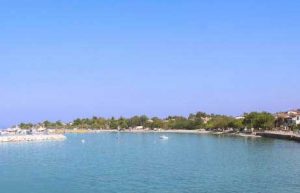
CENTRAL EVIA
Starting from Chalkida, we follow the coast road south-eastward towards Aliveri, coming first to the villages of Mytikas and Vasiliko. There is a Frankish tower at Vasiliko, with two more a short distance away on hills affording fine views of the entire plain and the sea. At the nearby community of Phylla is the Venetian castle of Likario (13th-15th c.). The sea-side resorts of Lefkandi and Malakonda have good swimming and a large number of tourist facilities. Archaeological excavations this area have brought to light some important finds from settlements dating from prehistoric times to the Geometric period.
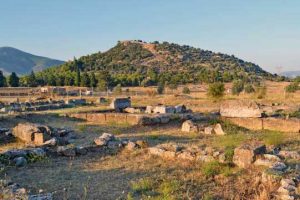
There are also the ruins of the large temple of Apollo Daphnephoros, roughly in the centre of the archaeological site, remains of the temple of Isis, the palaestra, the gymnasium, houses, and tombs at Livadia, by the sea. The Archaeological Museum contains important finds from the excavations at Eretria, Amarynthos and Lefkandi.
The Municipality of Eretria organises a cultural and athletics festival at the end of July beginning of August. The area of Eretria has many hotel units, restaurants, bars, entertainment centres, and facilities for a variety of water sports.
There is a bungalow complex on the pine-clad islet of Pezonisi to the right of the harbour. The island is connected to the town by a bridge. After Eretria we come to Amarynthos, a beautiful seaside town with a fine beach and fish-restaurants serving fresh fish and sea-food. A small sideroad leads to Ano Vatheia, a traditional village built on a ravine and rounded by verdant hills.
A short distance away is the nunnery of Ayios Nikolaos, in a superb natural setting. The nunnery church has some 16th c. wall paintings. To the east lies Aliveri, a town in which there is considerable commercial activity, to the south-east of which is a DEI (Public Electricity Enterprise) thermo-electric station. Just beyond the DEI facility we come to Rizokastro, one of the earliest castles of the Frankish period. A Mycenaean tomb was discovered in the area of Katakalos, 7 km to the north-east.
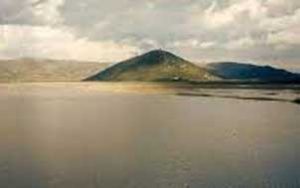
Other beautiful villages in this area, surrounded by lush greenery, include Ayios Georgios, Ayios Vlasis, Orologio, Monodry, Konistres, Oxylithos, Taxiarkhes and Pyrgos. Most of these are built on heights, enjoy wonderful views over the plane and the sea, and have attractive houses and carefully kept gardens. The road forks at Khania Avlonariou, with one branch going down to the coast and Stomio and Platana, traditional settlements that extend along an endless shore, with ample accommodation, tavernas and entertainment centres of all kinds. It ends at Paralia Kymis, an important harbour connecting Evia with the Sporades islands and Volos. The other branch of the road continues inland and leads to the beautiful town of Kymi, the ‘balcony over the Aegean’, as it is known, because of its superb view over the boundless sea (44 km from Eretria and 91 from Chalkida). It is built around the slopes of a hill with lush vegetation.
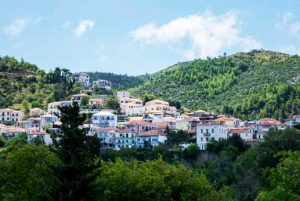
SOUTHERN EVIA
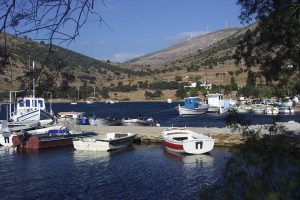
There is ample accommodation, as well as tavernas, at Nea Styra, and the settlement is connected by a frequent ferry service with Ayia Marina. The village of Styra is 4.5 km away, inland, spreading around a verdant hillside with a superb view of the sea. Further south there is a side road to Marmari, a populous village and harbour, from which there are boats connecting Evia with Rafina. The village has fine beaches, clear sea, adequate accommodation, and tavernas. The bay of Marmari has a scattering of verdant islets, called the Petali islands.
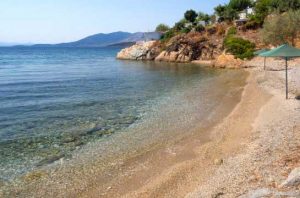
An ancient temple, which probably belonged to Apollo or Hephaistos, has been found in the centre of Karystos. To the east of the town, excavations have brought to light part of ancient Geraistos, while the Hellenistic acropolis of Karystos has been discovered near the village of Kokkali and the extensive Hellenistic cemetery at Palaiokhora. The archaeological museum of Karystos contains some important
finds from the surrounding area. There are severa cultural events Karystos, including performanc plays and exhibitions.
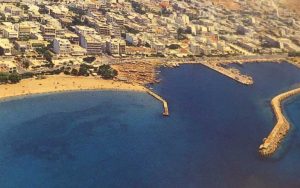
WHAT TO SEE
The capital of Evia, Chalkida, has been the capital since antiquity. It is a modern town today, with many shops, banks, bars, restaurants and so on. This is also where the bridge and ferryboats to and from the mainland are. Here, you can visit an interesting archaeological museum and see the ruins of ancient temples, as well as a 15th century fortress.
The second largest town is Eretria, and this was also an important financial and cultural centre in ancient Greece. It also has an archaeological museum, and you can see ancient ruins of a theatre, houses and temples here.
Kimi is situated high above the sea, and here you can visit a folklore museum, as well as ancient ruins and a Byzantine monastery. This is one of the oldest towns on Evia. Limni is another interesting town. Here, you can visit the nunnery of Galataki, and see ancient remains. Note: when visiting a monastery, make sure you are dressed accordingly: longs skirts and covered shoulders for women, long trousers for men.
Edipsos has had healing baths since ancient times, and you can enjoy the spas to this day. You can also visit the site of an ancient town here.
There are hundreds of villages on Evia to visit, and I might do injustice to those I don’t mention here. I want to assure you that there are many more to visit than the following.
Paleochora has an interesting cave, as well as several remains from antiquity. In Ano Potamia you can visit a kastro built by the Franks during the Middle Ages. In Rouvies there used to be an oracle dedicated to Apollo, and here you can visit an interesting monastery called Osiou David Geronta. At Orei there is another fortress built by the Franks, and nearby is the lovely plain of Istea. In Gialtra there are springs with curing waters. There are radioactive hot wells in Therma as well.
WHAT TO DO
One of the island’s top attractions is its beaches. From the bustling, organized beaches of Eretria and Amarynthos where families can enjoy a plethora of services and water sports, to the secluded coves and crystal-clear waters of Karystos or the thermal springs in Edipsos, Evia’s coastline caters to every preference.
Nature lovers and adventurers will find plenty in Evia to keep them entertained. The island’s diverse landscape includes mountains like Dirfys and Ochi which offer challenging hikes and breathtaking views from their peaks. The trekking paths leading through dense forests, over streams, and past waterfalls are perfect for a day’s adventure. For a more leisurely experience, the Dimosari Gorge near Karystos provides a less strenuous but equally rewarding hike, complete with a waterfall that’s perfect for cooling off during the summer months.
History and archaeology enthusiasts will appreciate Evia’s rich past, evident in its numerous archaeological sites and museums. The Archaeological Museum of Eretria displays artifacts from one of Greece’s ancient cities, while the ruins of the city itself, including a theatre and ancient temples, offer a glimpse into its historical significance. Similarly, the Dragon Houses (Drakospita) — ancient, mysterious stone structures atop Mount Ochi — provide a fascinating excursion for those intrigued by history wrapped in mystery.
Cultural experiences in Evia also abound. The island’s villages host traditional festivals and events, especially in the summer, where you can enjoy local music, dance, and culinary specialties. Experiencing a Greek panigyri (a traditional festivity) in a village square under the starlit sky is a must.
Evia’s culinary offerings reflect its cultural and geographical diversity. Seafood is a staple in coastal towns, freshly caught and served in local tavernas. The inland villages offer tastes of game and mountain meats, often paired with locally produced cheeses and wines from the island’s vineyards.
Finally, for those interested in a relaxing holiday, the thermal spas of Edipsos provide therapeutic treatments using mineral-rich waters that have been famous since ancient times. Whether it’s indulging in a spa day, lounging at a beachside café, or exploring ancient ruins, Evia offers a comprehensive Greek island experience without the crowds of more well-known destinations, making it a wonderful choice for travelers seeking a blend of relaxation, adventure, and cultural immersion.
BEACHES
Evia boasts an impressive array of beaches, each offering unique atmospheres and natural beauty, making it a premier destination for beach lovers. The island’s extensive coastline includes a diverse range of beaches from sandy to pebbly, secluded coves to organized stretches with ample amenities, each surrounded by Evia’s lush landscapes and crystal-clear waters.
Each of Evia’s beaches has its own character and charm, providing options for every type of traveler. Whether it’s lounging on a sunbed, enjoying the local seafood right on the shore, or exploring underwater life through diving or snorkelling, Evia’s beaches offer a comprehensive and diverse beach experience that can be tailored to any preference. Their beauty and variety encapsulate the essence of a Greek island paradise, making Evia a must-visit for beach enthusiasts.
Starting from the north, the beaches around Edipsos are renowned for their therapeutic thermal springs. Here, visitors can combine a traditional beach experience with the health benefits of natural hot springs, enjoying the warm, mineral-rich waters right by the sea.
Moving south, the central part of Evia features the vibrant town of Eretria. The beaches here, like Eretria Beach itself, are well-organized and family-friendly, offering a variety of services such as sunbeds, umbrellas, and water sports facilities, making it easy for everyone to enjoy a day by the sea. Nearby, the beach at Amarynthos provides a similar appeal with added charm of local tavernas lining the shore, where fresh seafood can be enjoyed just steps from the Aegean.
For those seeking a quieter experience, the eastern side of Evia presents a completely different scene. The beaches here are more rugged and less crowded. Beaches like Agia Anna and Psaropouli offer long stretches of sand with fewer amenities, which appeals to those looking for a more natural and serene beach environment. The waters are incredibly clear and inviting, perfect for swimming and snorkeling.
Karystos in the south showcases some of the most picturesque beaches in Evia. Potami Beach is a particular highlight, known for its golden sand and turquoise waters, backed by green mountains that provide a stunning contrast and lush backdrop. This area is less commercial and offers a more laid-back vibe, ideal for those who wish to relax and unwind.
Further exploring the western coastline, one finds a mix of small bays and pebbly beaches such as those near Limni and Rovies. These areas are popular among locals and offer a more traditional Greek beach experience, with several small cafes and eateries nearby serving local delicacies.
NIGHTLIFE
Evia offers a diverse nightlife and entertainment scene that caters to a wide range of tastes, providing visitors with a variety of ways to enjoy their evenings on the island.
Chalkida, the capital, is the hub of nightlife in Evia, boasting an array of options from lively bars and nightclubs to more subdued cafes and restaurants along its picturesque waterfront. The town’s promenade is especially popular in the evenings, where both locals and tourists gather to enjoy drinks and the cool breeze off the Euripus Strait. Several clubs in Chalkida play a mix of international hits and Greek pop music, creating a vibrant atmosphere that lasts well into the early hours.
Eretria also offers a vibrant nightlife but with a more laid-back vibe compared to Chalkida. The town has a selection of beach bars and tavernas that provide a perfect setting for enjoying an evening cocktail while watching the sunset over the sea. During the summer months, these spots often feature live music, ranging from traditional Greek to contemporary beats, enhancing the relaxed seaside ambiance.
Karystos, further south, is known for its tavernas and ouzeris where you can experience the local drinking culture. These establishments typically serve “meze” – small dishes of local specialties, accompanied by ouzo or tsipouro. The nightlife here is generally more traditional and is a great way to mingle with locals and immerse yourself in Greek culture.
In addition to bars and clubs, Evia also hosts various cultural events and festivals throughout the year, particularly in the summer. These events often include open-air concerts, theatre performances, and traditional dancing that showcase the island’s rich cultural heritage. The festivals are held in various towns across Evia and are a big draw for entertainment, often attracting a mix of international and local visitors.
EATING OUT
One of the defining features of Evia’s cuisine is its reliance on fresh, locally-sourced ingredients. Olive oil, a staple in Greek cooking, is used generously here and is often derived from the island’s own groves. Seafood also plays a pivotal role in the diet of Evians. The waters surrounding the island provide a bounty of fish and seafood that is featured prominently in the daily diet. Octopus, squid, and a variety of fish are commonly grilled, fried, or stewed with a minimal use of spices to let the natural flavors shine through.
Try Tsipouro accompanied by a meze of fresh seafood, typically enjoyed at seaside tavernas. Tsipouro is a strong distilled spirit that is similar to ouzo and raki, often consumed socially and paired with small plates of food.
Meat dishes in Evia tend to include lamb and goat, which are usually grilled or slow-roasted to perfection, often seasoned with local herbs like oregano, thyme, and rosemary which grow wild on the hillsides. A particular favorite is “kontosouvli” – large chunks of pork marinated in lemon and spices then slow-roasted on a spit over an open fire.
Cheese is another cornerstone of Evia’s culinary offerings. The island produces several varieties, including the sharp and salty “feta,” the creamy “anthotiros,” and “formaela,” a pungent aged cheese that is often grilled. These cheeses not only feature in appetizers and salads but also in pies and as fillings in various stuffed vegetables or meats.
Local produce like figs, olives, and citrus fruits often find their way into the local dishes, creating a wonderful blend of tastes. “Spoon sweets,” made from almost any fruit and preserved in syrup, are a traditional dessert offering in Evia. These are typically served with a glass of cold water and coffee, or sometimes over ice cream or yogurt.
Wine and spirits production is also notable in Evia, with the island hosting several small wineries that produce both red and white wines from local grape varieties.
SHOPPING
Evia offers a diverse shopping experience that reflects its rich cultural heritage and vibrant local economy. From bustling markets to quaint boutiques, the island provides visitors with plenty of opportunities to shop for traditional Greek products, local handicrafts, and contemporary goods.
In Chalkida, the capital of Evia, shoppers can explore the main shopping street where a variety of shops offer everything from fashionable clothing and accessories to electronics and household goods. The town is also known for its lively open-air markets where locals and tourists alike can find fresh produce, seafood, and spices. These markets are not only great for picking up daily necessities but also provide a glimpse into the local lifestyle and culinary traditions.
Handicrafts are a significant part of Evia’s shopping allure. The island’s artisans are renowned for their skills in creating beautiful handmade jewelry, ceramics, and textiles. These items are often sold in small workshops and boutiques scattered throughout the island’s towns and villages. Shopping for these unique pieces not only supports the local economy but also offers visitors a chance to bring home a piece of Evian craftsmanship.
Evia is also famous for its natural products. Local honey and olive oil are must-buy items, celebrated for their quality and flavor. Many small farms and cooperatives offer tours and tastings, allowing visitors to learn about the production processes and purchase these products directly from the source. Additionally, the island’s vineyards produce some excellent wines, which are available in local shops and at the wineries themselves.
For those interested in antiquities and cultural artifacts, Evia has several antique shops and galleries where you can find everything from ancient Greek pottery to Byzantine icons and other historical relics. These shops are particularly prevalent in the older, more traditional areas of the island where history buffs can enjoy a treasure hunt-like experience.
Lastly, for everyday shopping, Evia’s larger towns like Eretria and Karystos provide supermarkets, chain stores, and local shops where visitors can find clothing, souvenirs, and more. These areas are also home to cafes and restaurants, making them ideal spots for a combined shopping and dining outing.
GETTING AROUND
Hiring a car in Evia offers the most flexibility to explore the island at your own pace. Rental services are available at major entry points such as Chalkida and also in larger towns. Driving allows you to access more remote areas that are typically not served by public transport and to stop whenever and wherever you like, from hidden beaches to quaint villages. The roads in Evia are generally in good condition, though some rural areas feature narrow and winding paths that can be an adventure in themselves. Remember to have a valid driver’s license, and check if an international permit is required.
On the other hand, the KTEL bus service provides a cost-effective way to travel. It connects all major towns like Chalkida, Eretria, and Karystos, and also serves many smaller villages, albeit with less frequency in remote areas. To travel by bus, check the latest schedules on the KTEL website or at local stations, especially as times can change with the seasons. Tickets can be bought from the driver or at stations and it’s wise to get to your stop early to ensure you don’t miss your bus. Buses are usually timely, but it’s a good idea to plan for some flexibility in your schedule in case of delays.
Both modes of travel have their own set of advantages. With a car, you get the freedom to explore as you wish, ideal for reaching out-of-the-way spots and making spontaneous detours. Meanwhile, buses offer a relaxed pace and the chance to enjoy the landscape without the responsibility of driving. Whichever option you choose, Evia’s diverse landscapes from lush forests and mountains to serene beaches and bustling towns are accessible and waiting to be explored.
GETTING THERE
One of the most popular ways to reach Evia is by driving or taking a bus across one of the two bridges that connect the island to the mainland. The most commonly used bridge is the high bridge at Chalkida, which links directly to the central part of Evia and the island’s capital. This bridge is especially convenient because it sits at the narrowest point of the Euripus Strait, making it a quick and easy entry point from Athens. Driving from Athens to Chalkida takes about an hour and a half, depending on traffic.
Another option is to use the ferry services that link different parts of the mainland to Evia. There are several routes to choose from, such as the ferry from Arkitsa to Aidipsos in the northwestern part of Evia, which is popular among those traveling to the thermal spas in Aidipsos. Another route is from Agia Marina to Nea Styra, which provides a direct link to the southern parts of the island. These ferries accommodate both passengers and vehicles, making them a good option if you are traveling with a car.
For those preferring public transport, buses run regularly from Athens to various destinations across Evia. The main bus terminal in Athens offers frequent services to Chalkida, and from there, you can connect to local buses to reach other towns and villages on the island. The journey by bus can be longer than driving, especially if connections are involved, but it allows you to relax and enjoy the scenic views without the stress of navigating traffic.
Travelers can also consider combining these methods, such as driving to one of the ferry points and then taking a ferry to Evia, which can be particularly enjoyable during the summer months when the sea journey adds an extra element of adventure to your trip.
